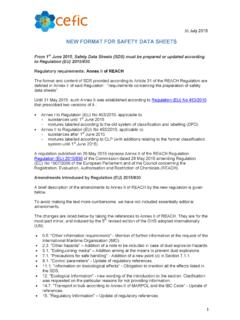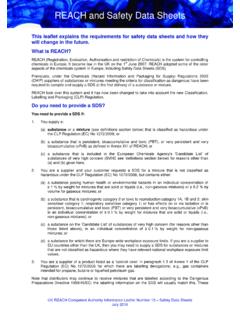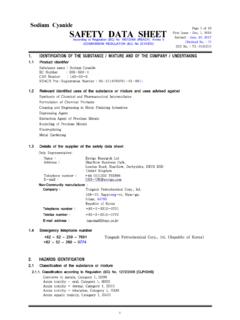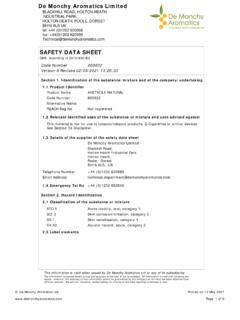Transcription of DICAN - Albaugh Europe
1 DICAN . safety DATA SHEET according to Regulation (EC) 2015 /830 Issue date: 16/06/ 2015 . Revision date: 10/04/2017. Version UK Page 1 of 9. 1. IDENTIFICATION OF THE MIXTURE AND OF THE COMPANY. Product identifier Trade name DICAN Relevant identified uses of the mixture and uses advised against ! Relevant identified uses A water dispersible granule formulation containing 50% w/w diflufenican. For the control of broad-leaved weeds in winter wheat and winter barley. Uses advised against Do not use for any other purpose. Details of the supplier of the safety data sheet Albaugh Europe S rl World Trade Center Lausanne Avenue Gratta-Paille 2. 1018 Lausanne, Switzerland Telephone: + 41 21 799 9130. Fax: + 41 21 799 9139.
2 Email: Web: Emergency telephone number For advice on medical emergencies, fires or major spills: +44 (0) 1235 239 670. Available: 24 h Time Zone: GMT. Language(s) of phone service: All major EU languages UK National Poisons Information Service: +44 (0)121 507 4123 (For health professionals only). Available: 24h Time Zone: GMT. Language(s) of phone service: English 2. HAZARDS IDENTIFICATION. Classification of the substance or mixture Classification according to Regulation (EC) no. 1272/2008 [CLP/GHS]. Signal word Hazard class and category Pictograms Hazard statement Warning Aquatic Acute 1 GHS09 H400 Very Toxic to aquatic life Aquatic Chronic 1 H410 Very toxic to aquatic life with long lasting effects Additional information For abbreviations, refer to Section 16.
3 Label elements Labelling according to Regulation (EC) no. 1272/2008. Hazard pictograms GHS09. DICAN . safety DATA SHEET according to Regulation (EC) 2015 /830 Issue date: 16/06/ 2015 . Revision date: 10/04/2017. Version UK Page 2 of 9. Signal word: Warning Hazard statements: H410: Very toxic to aquatic life with long lasting effects Precautionary statements: General - Prevention: P273: Avoid release to the environment Response: P391: Collect spillage Storage: - Disposal: P501: Dispose of contents/container to a licensed hazardous waste disposal contractor or collection site except for triple rinsed empty containers which can be disposed of as non-hazardous waste Supplemental statements: EUH401: To avoid risks to human health and the environment, comply with the instructions for use.
4 SP1: Do not contaminate water with the product or its container. Do not clean application equipment near surface water. Avoid contamination via drains from farmyards and roads SPe3: To protect aquatic organisms, respect an unsprayed buffer zone to surface water bodies as specified for the crop Other hazards None known 3. COMPOSITION / INFORMATION ON INGREDIENTS. Mixtures Description of the mixture: Mixture of diflufenican and co-formulants. Chemical Name CAS-No. EC-No. Index No. Concentration CLP (Reg. 1278/2008). (W/W) Classification Diflufenican 83164-33-4 - 616-032-00-9 50 % Aquatic Chronic 3; H412. Di- Acute Tox. 4; H302, H332. isopropylnapthalene 1322-93-6 215-343-3 - > < % Eye Dam 1; H318. sufonate, sodium salt STOT-SE 3; H335.
5 Kaolin Clay 1332-58-7 310-194-1 - >30 <40 % - Other ingredients to 100% Not classified Additional information For full text of H phrases, see Section 16. 4. FIRST AID MEASURES. Description of first aid measures General notes: If symptoms occur after exposure to this product, seek medical attention immediately and show the product label or this SDS. Remove to fresh air and keep at rest. Do not allow smoking or eating. Take off all contaminated clothing and footwear. Following inhalation: Remove to fresh air and keep at rest in half-upright position. Seek medical attention if symptoms arise. Following skin contact: Remove all contaminated clothing. Wash skin with soap and rinse with plenty of water. Seek medical attention if irritation arises.
6 Wash clothes before re-use. Following eye contact: Immediately rinse with water. Holding eyes open, continue rinsing for 15 minutes at least. Remove contact lenses as soon as possible. Seek medical attention if irritation arises. Following ingestion: If swallowed, DO NOT INDUCE VOMITING: seek medical advice immediately and show this container or label. Remove any residues from mouth and rinse it with plenty of water. Offer the casualty 1 or 2 glasses of water to drink. Never give anything by mouth to an unconscious person. Self-protection of first aider Personal protective equipment for first aid responders is recommended according to potential for exposure (refer to Section 8). DICAN . safety DATA SHEET according to Regulation (EC) 2015 /830 Issue date: 16/06/ 2015 .
7 Revision date: 10/04/2017. Version UK Page 3 of 9. Most important symptoms and effects, both acute and delayed The symptoms and the effects indicated in this section refer to an accidental exposure scenario. Following inhalation: Possible slight nasal irritation and discharge. No delayed effects expected. Following skin contact: Possible slight transitory redness. No delayed effects expected. Following eye contact: Possible slight transitory redness. No delayed effects expected. Following ingestion: Possible mild gastrointestinal effects. No significant delayed effects expected. Indication of immediate medical attention and special treatment needed No need to provide any special means/medicinal products for immediate treatment at the workplace.
8 Notes for the doctor: No specific antidote. Treat symptomatically (decontamination, vital functions). Call a Poison Centre immediately for treatment advice. In case of ingestion gastric lavage may be necessary (with proper laryngeal control). Before emptying the stomach, assess the potential danger arising from lung aspiration against the product toxicity. Report to Albaugh Europe S rl any unusual symptoms occurring after exposure by any route. 5. FIRE FIGHTING MEASURES. Extinguishing media Suitable extinguishing media: Carbon dioxide, water spray, alcohol-resistant foam, dry chemical for small fires, alcohol-resistant foam or water spray for large fires. Unsuitable extinguishing media: Solid water jet. Special hazards arising from the mixture Hazardous combustion products Evolves toxic and corrosive fumes in fire including carbon oxides, nitrogen oxides and hydrogen fluoride.
9 Advice for fire-fighters Clothing conforming to EN469 should be sufficient to deal with fires involving the product. A Self-Contained Breathing Apparatus (SCBA) is recommended to avoid inhalation of dust and combustion fumes. Additional information Provide storage and work areas with suitable fire extinguishers. Call the Fire Brigade at once to deal with all fires involving pesticides unless the fire is small and immediately controllable. Spray unopened containers with a mist spray to keep cool. If without risk, remove intact containers from exposure to fire. Contain fire- fighting water, bunding if necessary with sand or earth. Do not allow contamination of public drains or surface or ground waters. Dispose of fire debris and contaminated water as advised in the MAFF/HSE Pesticides: Code of Practice for the Safe Use of Pesticides on Farms and Holdings.
10 6. ACCIDENTAL RELEASE MEASURES. Personal precautions, protective equipment and emergency procedures For non-emergency personnel Precautions: Do not inhale the substance and do not use any cleaning method that generates airborne particles. Protective equipment: Wear prescribed personal protective equipment to prevent inhalation and contact with eyes and skin. A. Self-Contained Breathing Apparatus (SCBA) is required. Emergency procedures: Remove immediately any contaminated clothing. Call the emergency services if the release is not immediately controllable. If the release is localised and immediately controllable, wear a Self-Contained Breathing Apparatus (SCBA) and try and control the release at its source.






